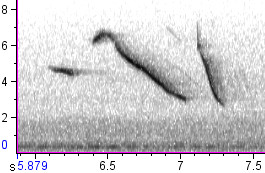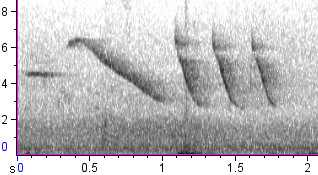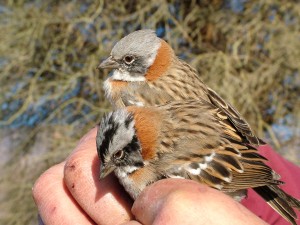Rufous-collared Origins
On May 8th, 2011, Andrew Davis of Winnipeg, Manitoba and his uncle, Tim Davis of Parker, Colorado, were stopped in the picturesque mountain hamlet of Georgetown, about an hour west of Denver, when they heard an odd whistled song that reminded Andrew of a Golden-crowned Sparrow. He later wrote:
As we were tracking it down I remarked to Tim that what it really sounded like was Rufous-collared Sparrow, which I am familiar with from trips to Costa Rica and a trip last fall to Ecuador. Imagine our surprise, though, when that’s what it turned out to be!
Indeed, the two had found a Rufous-collared Sparrow, a common and winsome bird of mountain habitats from Chile to southern Mexico, the only tropical member of the familiar genus Zonotrichia. Several thousand miles north of the species’ known breeding range, the Georgetown bird became something of a celebrity, and birders flocked to see it.

Naturally, many people wondered about the origin of the bird. Some argued that because Rufous-collared Sparrows are popular as cage birds, the individual in Georgetown was likely an escapee from captivity; others held that the bird might well have arrived in Colorado under its own power. Some in the latter crowd, I suspect, wanted to see Rufous-collared Sparrow added to the official Colorado state bird list; therefore they had a personal emotional investment in the notion that the bird might have flown to Colorado by itself. Different people had different reasons for engaging in or avoiding this debate over origins; see Ted Floyd’s post on the ABA blog for a convincing argument that the bird is “worthy” regardless of its immigration status.
As a birder who appreciates the beauty and behavior of birds no matter when or where I find them, I agree with Ted. However, I am also keenly interested in discovering the sparrow’s origins, not just to provide fodder for the natural-vs.-exotic debate, but because the answer is bound to be interesting from a biological perspective. Is this an opportunity to learn about what happens when a bird’s migration mechanism fails catastrophically? Or is it an opportunity to learn how a (formerly) caged bird can adapt to alien climates and communities? Either way, it’s an opportunity.
Geographic origin
The first thing most people wanted to know was what part of the species’ vast range this individual sparrow had come from. One line of thinking held that if it had arrived under its own power, it most likely came from the geographically nearest population in extreme southern Mexico — and, conversely, if the bird had originated in Mexico, it was more likely of natural origin.
Others argued that it should be the migratory tendencies of populations, rather than their geographic proximity to Colorado, that would provide the best evidence for a natural vagrant. The populations in Mexico and Central America are non-migratory; in fact, they apparently hardly wander even a few kilometers from their breeding territories, making them very unlikely indeed to have sent a scout to the United States. Populations in Chile and Argentina, however, are austral migrants — they breed in austral temperate zones during the southern hemisphere’s summer (our winter) and then migrate north, sometimes thousands of kilometers, when southern winter arrives. Odd as it may seem, even though they are normally found many thousands of miles farther away, austral migrants are much more likely to fly to the United States than sedentary tropical birds. For example, the majority of the 100+ Fork-tailed Flycatchers that have arrived in this country are of the subspecies that breeds in Patagonia, not the subspecies that breeds thousands of miles closer in central Mexico (though that one shows up in Texas sometimes).
In between the sedentary Central American populations and the austral migratory populations are a whole bunch of stay-at-home tropical mountain Rufous-collared Sparrows. Most people interested in the Georgetown sparrow tended to agree that if it was found to come from a distant tropical area — say, Costa Rica or Ecuador — it was most likely an escaped cage bird.
Song sleuthing
When I heard reports that the Georgetown sparrow was singing loudly and often, I immediately wondered whether it might be possible to use its song dialects to pinpoint its birthplace.
Like its relative the White-crowned Sparrow, the Rufous-collared Sparrow in much of its range sings only a single songtype, and these songtypes vary regionally. As it happens, Rufous-collared Sparrows have one of the best-studied songs of any bird species, and a great deal of that research has been done by Paul Handford of the University of Western Ontario. In a 2005 article in Birding magazine, Paul laid out the evidence that different trill speeds at the ends of Rufous-collared Sparrow songs correpond to different habitats. I thought that maybe, given the many spectrograms that he had published, in addition to the vast number of recordings of Rufous-collared Sparrows on Xeno-Canto, we might just be able to find a songtype that matched the Colorado bird.
I made a couple of trips to record the bird, and was able to get its voice on tape on two different days in June. The first time I heard it, it was singing a three-note song without a trill:

Paul said this was typical of early-season breeding songs:
It was giving what we call ‘incomplete’ songs – ones lacking the terminal trill – which is usual for birds very early in the season, before the gonads have reached breeding size.
And indeed, a week later, I found the bird giving the same songtype with a somewhat extended terminal “trill.” It’s pretty darn slow to be called a “trill,” but some populations of Rufous-crowned Sparrows give very slow trills like this, according to Paul’s research.

Paul found slow trills like this in some migratory populations in Argentina. However, since even the “long” form of this song is quite short, it may simply be another version of the incomplete song.
Besides trill type, Paul indicated that repertoire size was the other key factor in trying to determine the bird’s origin:
If the bird is now producing two distinct song types then this suggests to me that the bird is of tropical origins since individual repertoires are only known to be well-represented in Ecuador; in south temperate and subtropical populations, individual repertoire size is one, as usual in Zonotrichia. In Ecuador on the other hand, individuals have been recorded with up to seven very distinctive song types!
Well, guess what? A little later on my second visit, the Georgetown bird started belting out this song:

And then, a little later, this one:

Interestingly, the last songtype I recorded is the same as the one the bird is singing in the video that Connie Kogler took on May 19:
http://www.youtube.com/watch?v=SDWkk_v5It4
Conclusion? The bird appears to be from an equatorial population with multiple songtypes, NOT a migratory austral population, nor a Central American population, as far as I can tell. What does that mean for the likelihood that the bird got to Colorado by itself? I’ll leave you to draw your own conclusions, but one thing is clear: careful listening (and recording!) is of tremendous help in solving mysteries like these.
— Update —
Got an email from Paul Handford in response to my post, with lots of great additional information. Here’s what he wrote. (Note that chingolo is the name of the Rufous-collared Sparrow in South America.)
Your second recording (the one following the ‘incomplete’) sounds like a bona fide complete ‘theme + trill’ to me. There’s several places that I have encountered songs with such ‘slow’ trills with only 3-4 trill elements, like this one. Nothing about it strikes me as weird or unusual.
On the other hand your third songs are out of my experience — they sound like nothing I have heard before. If I were to hear them in the field, my antennae would definitely waggle about thinking “sounds like maybe a chingolo there”, but they have a quality unknown to me. But then, there’s an entire continent of chingolo songs that I haven’t heard!
The fourth songs again have the quality of incompletes, but also are a bit weird.
All together, there’s only one song that sounds truly ‘kosher’ to me as a complete well-formed song (your second ones). What the 3rd and 4th songs mean is an open question to me: but they don’t impress me as necessarily fully-crystallized songs.
One thing you don’t mention in your discussion is that we can definitively rule out the longest-distance migrant populations, for these have very distinctive head plumage – they completely or effectively have lost the black head stripes (see attached for an in-hand comparison of birds netted in early spring at Lat ~26°S; the stripey one is a local bird and the grey-head is still on its way to the far south).
So my guess coincides with yours: it is a tropical latitude bird; further than that I don’t see us going — without DNA sequencing, at least.
A final thought: there’s a good chance that this is a first year bird; there’s evidence that even nominally single-song birds can continue to learn songs (i.e. there’s not a classic closed learning period) at least into their second year (and, as noted before, Ecuadorean birds can evidently learn over an extended period). All this raises the possibility that, rather than having as it were brought these three song ‘types’ with him, this little guy MIGHT be emulating something local in Georgetown. It seems clear (at least to me) that this bird is counter-singing with local white-crowns; maybe it is also interacting with other taxa? And maybe it learned other notes while it was perhaps living in a cage??
Fascinating possibilities.
Here’s the photo Paul sent with the email:

4 thoughts on “Rufous-collared Origins”
Thank you for the great analysis of the song. I would still love to see the bird.
This is very interesting Nathan. The litterature also mentions that some of the many subspecies of Rufous-collared Sparrow are distinctly marked. Did you try to match the face pattern of the Georgetown bird with any photographs of known subspecies from the equatorial regions of the Neoptropics and from the few subspecies that are Austral migrants?
Great essay, Nathan! I still like the theory that the bird accompanied the shipment of rescued circus lions which arrived on a direct flight to Denver from Bolivia. I wonder if Bolivian Rufous-collared Sparrows have multiple song types.
Nathan – I can add a few things from a Chilean perspective. First of all “chingolo” is the Argentine/Uruguayan, not the South American name. They are called “chincol” in Chile 🙂 The migratory status of various forms in Chile is still not fully understood. The southern australis (no stripes on head) moves north and probably all winter in Argentina, not the Chilean side. These are birds that breed in Patagonia where it gets quite cold in winter. There are other populations in the mountains, at least to the latitude of Santiago that are also migratory, as at these latitudes and farther south winter in the mountains is no picnic. Some of these have head stripes, although not all forms. But the migratory types have a lot longer wing than the residents. It is perhaps more extreme than in White-crowns, where nuttalli has a much shorter primary projection than gambelli for example. From what I could see in photos of the Colorado bird, it looked like a shorter winged creature.
Comments are closed.